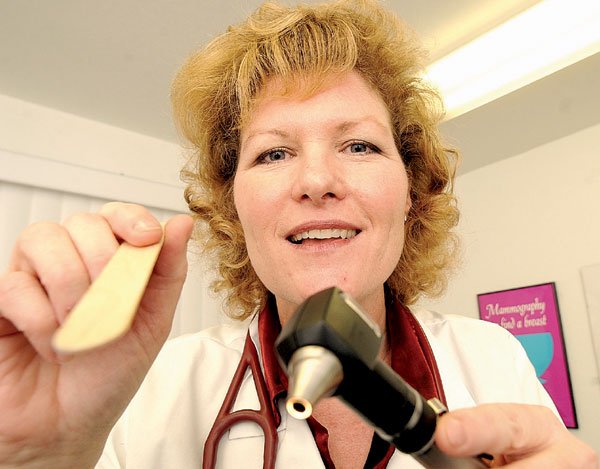There’s something old-fashioned about walking into a family
doctor’s office.
No matter how new or modern the waiting room, it’s still likely
to contain at least one issue of Field
&
amp; Stream, one of several women’s magazines and a little
something to amuse the kids.
There’s something old-fashioned about walking into a family doctor’s office.
No matter how new or modern the waiting room, it’s still likely to contain at least one issue of Field & Stream, one of several women’s magazines and a little something to amuse the kids.
The doctors’ roles in families’ lives haven’t changed that much either over recent generations, and that’s reassuring to patients. When someone has a health problem or question, the family doctor is usually the first one they go to. The doctor diagnoses the ailment, treats what he or she can and, for the rest, may prescribe drugs or tests or refer the patient to a specialist.
“Then, they usually come back to us for follow-up,” said Dr. Joseph Barbara (pronounced Bar-BAR-a), a private family doctor in Gilroy since 1974. “In fact, quite often, even after a patient sees a specialist, they’ll come back to us to find out, ‘What did the specialist mean by this?’ or ‘What does this imply?'”
The family physician is the one who gets to know every member of a family over time, the one they feel most comfortable with. Other members of a patient’s health team play critical roles – specialist doctors, nurses, pharmacists and X-ray technicians, for example – but the family doctor is the quarterback who calls the plays.
But when the family doctors of Barbara’s generation retire, who will take their place? Fewer medical students are choosing family practice, and Barbara doesn’t know of any new, young doctors in Gilroy.
“Over the … 30 years that I’ve been in practice, I don’t really think we have many more (family doctors) now than when we started,” Barbara said. “The town has grown a lot, but the number of doctors has not.”
According to the American Academy of Family Physicians, only 76.2 percent of family practice residency openings in the United States were filled in 2003, down from 79 percent the year before and a peak of 90.5 percent in 1996. Of the 2,239 resident family doctors hired in 2003, 45 percent came from outside the United States.
Why are American med students avoiding family practice? According to an April 2003 AAFP report, the reason is “a quagmire of declining reimbursement, increasing regulatory burdens and flagging federal support of family medicine training programs.”
New Hollister doctor Cindy Nelson noticed the trend while teaching young resident doctors in Denver. She said the income of a family physician today is noticeably less than it once was – around $45 an hour in Hollister, based on her recent job search.
“My cousin, who’s a nurse, is making more than that,” Nelson said.
To make it work, doctors often join their practices together to share business expenses. Nelson, who started work Jan. 5, shares a practice with Dr. Peter Ceolho.
“That’s why a lot of physicians aren’t in solo practice anymore, because it’s hard to run a small business,” Nelson said.
Before moving to Hollister, Nelson practiced for 10 years in Denver. She grew up in San Jose, has been living with her parents there since the fall and is now looking for a home in Hollister.
“It’s surprising how many doctors avoid private practice these days simply because they don’t want to have to deal with the business aspects of it,” Barbara said. “They’d rather work for some other organization, get a paycheck and not have the other worries.
“I think that’s why you’re seeing fewer family practitioners,” Barbara added. “Most physicians are joining Kaiser and other big groups and, for that reason, probably go into specialties because those are the kind of doctors that those groups primarily hire.”
Meanwhile, family practitioners’ control over their patients’ care has weakened since the dawn of managed health insurance a decade ago. Three of the four doctors interviewed for this article said their jobs have gotten more difficult since health management organizations (HMOs) became common in the early 1990s.
“With the increase in HMOs, the physician no longer can decide which specialist to send his patient to, which tests he can get on his patient, even which medications he can give to his patient,” Barbara said. “All of those have to be approved by the HMO first. … It becomes very frustrating sometimes when you can’t give your patient the best medication that’s available or do the type of tests you think would most likely give you the answers to what’s wrong with the patient.”
Dr. Hilla Irani, a family doctor in Hollister for the last 24 years and for 29 years in total, agreed.
“You’re not as much in control, and there’s too many other entities telling you what to do,” she said.
Nevertheless, Irani isn’t ready to retire anytime soon.
“I’m still doing what I like,” she said. “It might be difficult at times, but if you enjoy what you do, you do it. That’s what’s satisfying.”
What makes it satisfying? The variety, the involvement in families’ lives and the notion that, in Irani’s words, “You can make a difference as a family’s physician.”
In Gilroy, Barbara said his job is “a lot less fun” than it once was – but it’s still fun.
“There are more aggravations,” Barbara said. “More paperwork … is being required by the insurance companies, while they’re paying less. Most doctors these days are working more and more and actually receiving less for it.
“The fun part, of course, is meeting new people every day, taking care of patients who have been coming to you for many years. You almost develop one big family after so many years.”
Despite their second-guessing to cut spiraling health costs, insurance companies still recognize the family physician’s key role in the health care network. They still recommend that their customers take matters to their family doctor first, not skip that step’s cost and go straight to a specialist or pharmacist.
Even if one needs a specialist, Barbara said, one’s family doctor can make sure to recommend the right one.
“Many times a patient will go to the wrong specialist,” Barbara said. “They may have a headache and go to a neurologist when they should be going to an ear, nose and throat specialist, so the end result is that it’s much more costly rather than less costly.
“The insurance companies realize that’s the best system, that’s the least expensive system.”
Like Barbara in Gilroy and Irani in Hollister, Dr. Frank Huang has been developing rapport with patients in Morgan Hill for more than two decades. He moved his private practice to Morgan Hill from Ohio in 1978 and is now considering retirement in a few years.
Unlike Barbara and Irani, however, Huang doesn’t feel like HMOs have made his job any harder.
“It’s comfortable,” Huang said of his career. “If I had to make the choice (again), I would do this. I wouldn’t go into surgery.”
Why not? Simple. Malpractice insurance.
Malpractice insurance for family doctors is downright reasonable compared to that of many specialties, such as surgery and obstetrics/gynecology. Barbara estimated that a doctor like himself pays $10,000 a year, whereas an OB/GYN could pay $100,000 annually.
That’s why many family doctors have stopped delivering babies, removing tonsils and other common but major procedures, Huang said. He still does minor procedures like ingrown toenails and pap smears, he said, but he can’t deliver enough babies to afford the higher insurance.
Nelson, however, does plan to deliver babies in Hollister. That’s one of the parts of her job she likes best. The only thing that’s more fun is caring for the family as the baby grows up.













